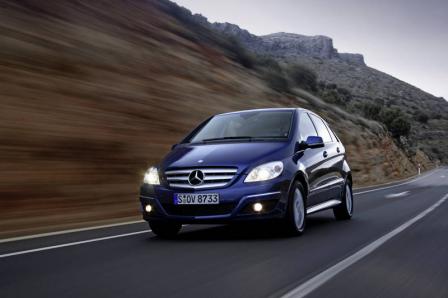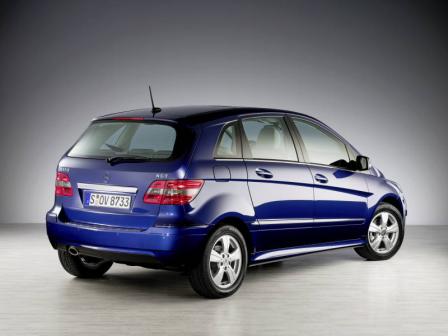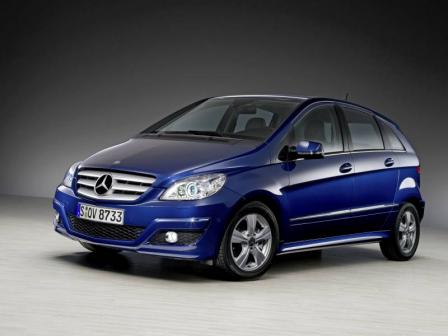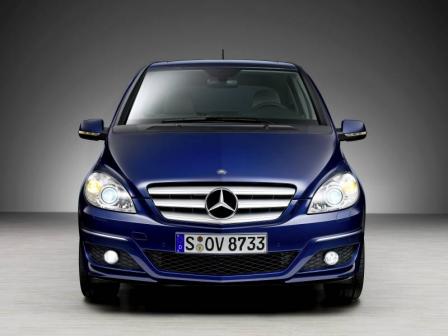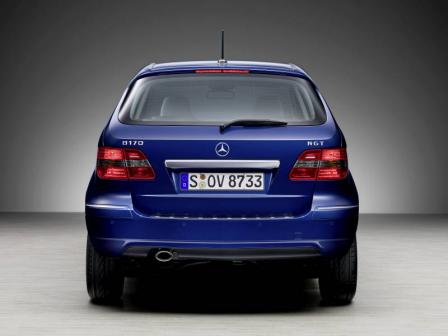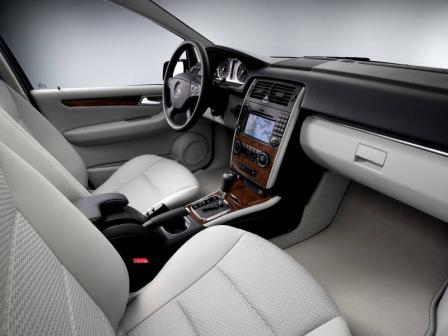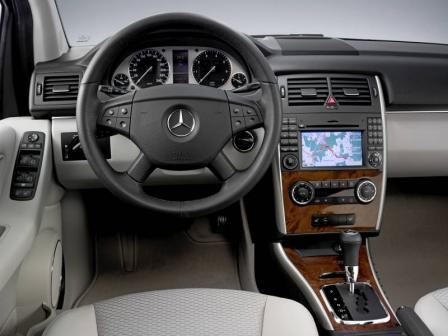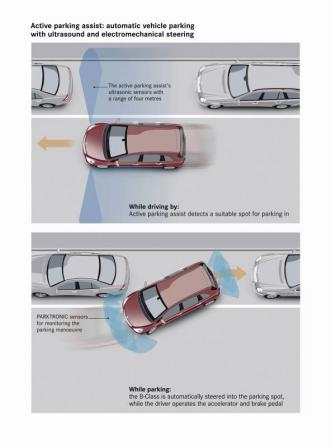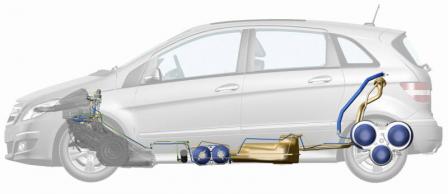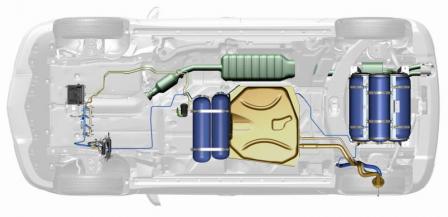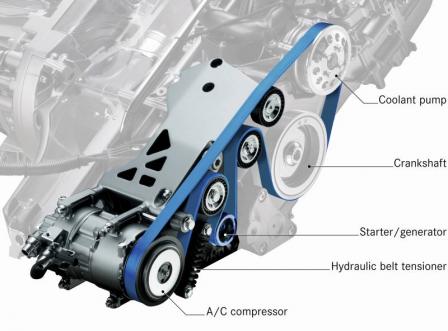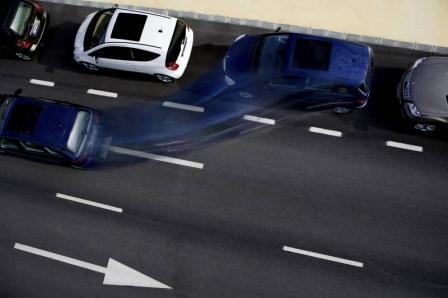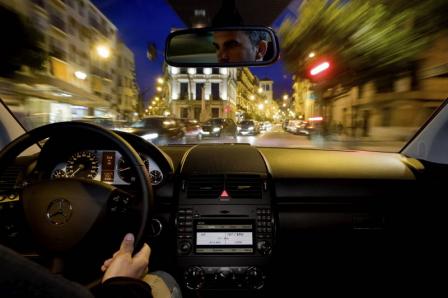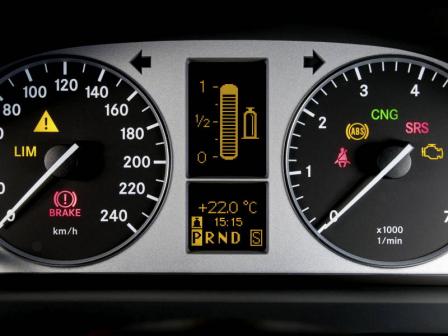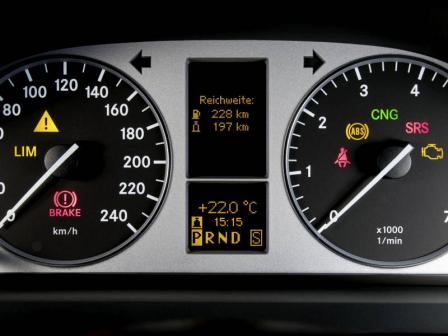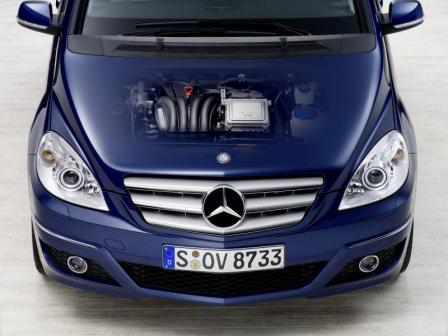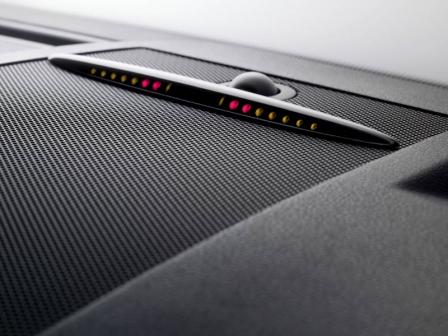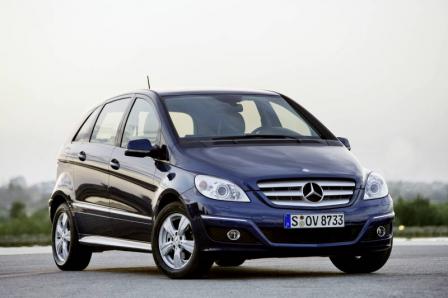Mercedes-Benz B-Class Facelifted
Nuno March 17, 2008Ok, so the B-Class is not exactly MB’s flagship model and is not available in the US, but still, the Sport Tourer has sold about 325,000 units since 2005. As Mercedes apparently is updating the majority of their cars, its time for a refresh. On the outside you will find a newly styled hood, grille, front bumper, high-brilliance tail lights and rear bumper. Major innovation is the new B 170 NGT BlueEfficiency. It features an entirely new natural gas powered engine and is capable of running on both natural gas and premium grade petrol. It delivers 85 kW/116 hp, the same as the petrol powered version. It can go about 1,000 km without refueling. The rest of the lineup is the B150 (95 hp), B180 CDI (109 hp), B200 CDI (140 hp), B170 (116 hp), B200 (136 hp) and B200 Turbo (193 hp).
More pictures and full details after the break
Official Press Release
Mercedes-Benz B-Class: Sports Tourer in better shape than ever
Stuttgart – After three successful years, Mercedes-Benz has overhauled the design and engineering of the B-Class. The facelift programme focused on environmental compatibility, economic efficiency and comfort, with further advances being made in each of these areas. Thanks to a series of detailed improvements, the four-cylinder engines now burn up to seven percent less fuel than previously, and distinguish themselves with remarkably low exhaust emissions that undercut the current EU limits by as much as 90 percent. Mercedes-Benz has developed a new ECO start/stop function for the high-volume B 150 and B 170 models. This switches off the engine when stopped at traffic lights, for example, producing a fuel saving of up to nine percent in practical use. Additional new developments include the bi-fuel petrol/natural-gas drive in the B 170 NGT BlueEFFICIENCY, along with active parking assist which helps drivers to both find a suitable parking spot, and then manoeuvre into it.
Since its market premiere in summer 2005, the B-Class has evolved into the blueprint for a new species of car which harmonises the benefits of various vehicle concepts: the four-door model boasts the dynamic design of a sporty saloon, the exterior dimensions of a compact car, the spaciousness of an estate, the versatility of a mini MPV and, of course, the trademark safety of a Mercedes-Benz.
The sales figures for the B-Class to date provide clear evidence that the Mercedes-Benz product planners hit the mark with a concept that caters to the motoring needs of today’s sophisticated society: since mid-2005, over 325,000 motorists around the world have been won over by the Sports Tourer.
The restyled front end injects the B-Class with even more poise and assurance than before. This is primarily down to the radiator grille with its three chromed cross fins painted in metallic grey and the Mercedes star integrated into its centre. However, the more imposing appearance of the B-Class also stems from the new-look bumper – whose design emphasises the large air intake at the bottom – as well as the modified bonnet.
Design: restyled front end creates a powerful presence
This new design idiom makes the front look broad and, as a consequence, especially powerful, symbolising the sporty attributes of the B-Class even more clearly than before. Aside from power and performance potential, these qualities include the car’s agility and its forwards thrust, something which is further underlined by the more pronounced arrow shape of the bonnet, radiator grille and bumper. This has the effect of making the entire front section appear to be surging dynamically forwards – a highly expressive styling element of the current Mercedes design idiom, which can be appreciated better than ever before in the 2008 model year version of the B-Class. The front end’s arrow shape is continued rearwards in the form of an understated but effective line running up the centre of the bonnet.
Typical distinguishing features of the current Mercedes style are also very much in evidence in the side profile of the B-Class, which presents a thrilling interplay between taut forms and crisp lines. Of particular note is the character line, which rises progressively from the front wing to the rear tail light, thereby marking an intriguing divide between the concave and convex-formed surfaces along the body’s flanks. This line furthermore underscores the body’s wedge-shaped form, and thereby gives added impact to the Sports Tourer’s athletic, powerful nature.
In the 2008 model year B-Class, the design at the sides seems even more harmonious and elegant than before because the exterior mirror housings, door handles and skirt panels are now painted to match the body colour on all model variants. The restyled hubcaps and light-alloy wheels add further touches of class to the exterior looks.
The rear styling picks up on the dynamic flow of lines at the front and along the sides. A direct visual link is created by the tail light assemblies, whose upper edges merge seamlessly with the character line along the vehicle’s sides. The tail lights sport a new high-brilliance look and draw the gaze to the large tailgate, which now comes with en ergonomically enhanced chrome handle strip. The rear bumper has been remodelled too, and includes a black-grained plastic insert on its upper face as standard which serves as a load sill guard. If the B-Class is specified with either the chrome or the sports package, this insert is made of polished stainless steel instead to add yet another gleaming highlight to the tail’s design.
Interior: high-grade appointments with new upholsteries and trims
High-class appeal, attention to detail and a sense of ample spaciousness – these qualities have always been intrinsic to the B-Class. The winning blend of forms, colours and materials teams up with the interior’s roominess, the pleasant feel of all its surface materials and the expansive window areas to produce a most inviting ambience. This is helped by the high seating position – which, incidentally, improves the driver’s view of the vehicle too – while the relatively high waistline fosters a sense of security without making the occupants feel confined in any way.
The Mercedes design team has further upgraded the interior with a new upholstery fabric, plus a new fabric pattern for the seat cushions. If the B-Class is ordered with the sports package, the side seat bolsters are trimmed in ARTICO man-made leather and the centre panels in fabric. The interior door linings likewise feature a new fabric trim.
The centre console continues to be bordered by trim strips on both sides, but they are now made from diagonally brushed aluminium in a smoke grey finish. The same, meticulously integrated trim is found again in the vicinity of the gearshift and in the door panelling, giving the interior an added sense of refinement. Such fine touches demonstrate just how much attention to detail has been invested in even the basic version of the B-Class, as well as the high standards to which it has been specified.
Diesel engines: fuel consumption reduced by a further seven percent
The B-Class continues to be available with a choice of six engines – two direct-injection diesel units (80 kW/109 hp and 103 kW/140 hp) delivering up to 300 Newton metres of torque, as well as four petrol engines with a peak power output of up to 142 kW/193 hp and a maximum torque of 280 Newton metres. The four-cylinder power units have undergone a series of detailed improvements in order to further reduce fuel consumption.
For the diesel models, this means that the combined NEDC fuel consumption of the B 180 CDI and B 200 CDI has dropped by as much as seven percent – depending on tyre size – to 5.2 – 5.4 and 5.4 – 5.6 litres per 100 kilometres, respectively. The two turbodiesel models will therefore be an even less seldom sight at the filling station from now on; the B 180 CDI can clock up over 1000 kilometres on a single tank of fuel (54 litres).
Petrol models: new fuel-saving ECO start/stop function
Depending on the model and engine output, the four petrol variants of the B-Class return fuel consumption figures of between 6.6 and 8.1 litres per 100 kilometres on the NEDC driving cycle. From autumn 2008, motoring is set to become even more economical with the arrival of the B 150 and B 170 BlueEFFICIENCY models featuring the ECO start/stop function (optional). This newly developed function automatically switches the engine off when the driver shifts to neutral at low speed whilst depressing the brake pedal. If the criteria for stopping the engine are fulfilled, a special display appears in the instrument cluster to inform the driver.
The moment the clutch is pressed or the brake pedal released, the engine springs back to life almost noiselessly and in a fraction of a second. This ability to restart the engine swiftly yet smoothly gives the ECO start/stop function a key edge over other systems of this type. To achieve this, Mercedes-Benz fits a starter-generator which is connected to the crankshaft via the belt drive. This allows the engine to start much faster and far more quietly than with the conventional starter. During the journey, the starter-generator feeds the electrical system on board the B-Class with energy.
In practical operation, substantial fuel savings of up to nine percent can be achieved with the ECO start/stop function, particularly when driving in city traffic with frequent stops at traffic lights or in tailbacks.
Natural-gas drive: a clean and economical alternative
A further new addition to the B-Class range bears the initials “NGT” on the right-hand side of its tailgate. They stand for “Natural Gas Technology” and identify a model variant which is as economical as it is environmentally compatible, courtesy of its bi-fuel drive: the B 170 NGT BlueEFFICIENCY is able to run on both natural gas and premium grade petrol while delivering an identical maximum output of 85 kW/116 hp.
In addition to the petrol tank, there are five natural gas reservoirs whose total capacity of 16 kilograms equates to a range of over 300 kilometres. With overall NEDC consumption figures of 7.3 litres of premium petrol and 4.9 kilograms of natural gas per 100 kilometres, the new B 170 NGT BlueEFFICIENCY is therefore able to attain a total range in excess of 1000 kilometres. The driver determines which power source the engine is run on at the touch of a button using the multifunction steering wheel; an electronic control unit carries out the switch instantaneously without any jolts – even while on the move.
The four-cylinder engine has been modified by Mercedes-Benz to include additional gas injectors on the underside of the intake manifold. A close-coupled pressure governor with electromagnetic shut-off valve regulates the supply of natural gas and keeps the pressure within the system constant.
The installation of the gas reservoirs, which are located in the rear and underneath the front passenger footwell, reduces the boot capacity of the B-Class by 128 to 422 litres (as per the VDA measurement method), but there is still sufficient space for carrying a family’s luggage.
The lower carbon dioxide emissions and cheaper fuel costs make natural gas an attractive alternative to petrol and diesel, both ecologically and economically speaking. On the NEDC cycle, the CO2 emissions are 17 percent lower than in the petrol-powered B 170 at 135 grams per kilometre. If the 4.9 kilograms (7.5 m³) of natural gas consumed per 100 kilometres by the new B 170 NGT BlueEFFICIENCY is converted into the equivalent quantity of petrol energy, the fuel cost per kilometre is around 50 percent less than when running on petrol.
Key B-Class engine, performance and fuel consumption figures at a glance:
| B 180 CDI | B 200 CDI | B 150 | B 170 | B 170 NGT | B 200 | B 200 TURBO | |
| Displacement cm³ | 1991 | 1991 | 1498 | 1699 | 2034 | 2034 | 2034 |
| Output kW/hp | 80/109 | 103/140 | 70/95 | 85/116 | 85/116 | 100/136 | 142/193 |
| Max. torque Nm | 250 at 1600- 2600 rpm | 300 at 1600- 3000 rpm | 140 at 3500- 4000 rpm | 155 at 3500- 4000 rpm | 165 at 3500- 4000 rpm | 185 at 3500- 4000 rpm | 280 at 1800- 4850 rpm |
| 0-100 km/h s | 11.3 | 9.6 | 13.2 | 11.3 | 12.4 | 10.1 | 7.6 |
| Top speed km/h | 183 | 200 | 174 | 184 | 184 | 196 | 225 |
| NEDC consumption l/100 km* | 5.2-5.4 | 5.4-5.6 | 6.6-6.8 | 6.8-7.1 | 7.5 m³ | 7.2-7.5 | 7.9-8.1 |
| CO2 emissions g/km** | 137-140 | 140-148 | 158-163 | 163-171 | 135 | 173-180 | 190-195 |
*combined consumption; **in NEDC driving cycle
Environmental Certificate: first ever lifecycle assessment for NGT drive too
Mercedes engineers have, for the first time, compiled an eco balance sheet for the natural-gas drive. It forms one element of the Environmental Certificate awarded to the B-Class by Germany’s TàœV Technical Inspection Authority. Mercedes-Benz is the only automotive brand in the world to have been granted this certificate, which is based on the stringent international standard ISO 14062 “Design For Environment”. It is a confirmation of the Stuttgart-based brand’s total commitment to all aspects of environmental protection. In contrast to just the standardised measurement of exhaust emissions and fuel consumption on the roller dynamometer, Mercedes engineers analyse the environmental compatibility of vehicles over their entire lifecycle – starting with their manufacture, continuing with their many years of use and finishing with their end-of-life disposal.
In all, over 40,000 individual processes come under scrutiny, whose analysis, computation and evaluation ultimately produce a comprehensive eco profile. This in turn forms the basis for the environmental certificate of the B-Class.
The results of this integrated analysis over a total distance travelled of 150,000 kilometres highlight, for example, a number of clear advantages for the natural-gas drive. The overall CO2 emissions are some 20 percent below the figure for the comparable petrol-engined model. Nitrogen oxide emissions are eleven percent lower, while the experts have calculated a 54 percent difference in carbon monoxide emissions over the entire lifecycle in favour of the natural-gas drive. The greater ecological cost of the manufacturing process for the new B 170 NGT is therefore balanced out after a distance of 17,300 kilometres.
The environmentally driven concept of the B-Class is clearly evident from its use of high-quality recycled plastics, for instance, or its components made from natural materials, including flax, cotton, coconut fibre, wood veneer and fibres from the abaca banana.
Mercedes-Benz has put together a brochure containing detailed information about the environmental certificate awarded to the B-Class, and published it on the internet at www.media.daimler.com .
Occupant protection: extensive safety features enhanced yet further
When it comes to safety, the B-Class sets an example for all other models of these dimensions to follow: in the European NCAP test programme, the Sports Tourer was awarded the highest rating of five stars.
The comprehensive safety specification, comprising two-stage front airbags, belt tensioners for the front and outer rear seats, belt force limiters plus active head restraints in the front, ISOFIX child seat attachment points and head/thorax sidebags, has now been complemented by the addition of crash-responsive emergency lighting in the passenger compartment. Following an accident
of a predetermined severity, the lighting comes on automatically to allow the occupants to get their bearings more easily in the dark and expedite the work of the rescue services.
Active safety: flashing brake lights as warning to other motorists
Accident prevention is the overriding priority of the Mercedes safety concept – a concept that is geared towards motoring reality. To help them bring critical situations under control safely and with ease, drivers of the B-Class can count on highly effective, standard-fit technology in the form of systems such as ABS, Brake Assist and ESP®. The Mercedes engineers have gone that little bit further though by seeking to devise a way of offering other motorists added safety too. The result is a simple but highly effective method of avoiding rear-end collisions: flashing brake lights. This safety technology is included as standard on the 2008 model year B-Class.
During testing, Mercedes engineers were able to ascertain that the braking reaction time of motorists is quickened by an average of 0.2 seconds if they see a flashing red warning signal instead of conventional brake lights in an emergency braking situation. This shortens the stopping distance by around 4.40 metres if they are travelling at a speed of 80 km/h, and by a whole 5.50 metres or so when braking from 100 km/h. Brake lights flashing at a high frequency therefore prove to be an effective means of alerting drivers behind to the risk of a rear-end collision.
The flashing brake lights are triggered automatically if the driver initiates emergency braking when travelling at a speed of 50 km/h or more. And if the B-Class is braked to a stop from a speed of over 70 km/h, the hazard warning lights will come on too.
Assistance systems: automatic parking with ultrasound and electric steering
The Electronic Stability Program has been expanded to include a new, standard function: the automatic hill-start assist. This prevents the B-Class from rolling backwards as the driver switches from the brake to the accelerator pedal when starting off uphill. In such situations, the ESP® briefly maintains the brake pressure to make pulling away easy.
Reverse parking will also pose less of a challenge for motorists in future. The new active parking assist (optional) searches for an appropriate spot at the side of the road as the B-Class drives by, than takes care of all the steering manoeuvres as the driver reverses into it. How it works: at speeds below 35 km/h, ultrasonic sensors at the sides of the car scan the zones to the immediate left and right of the B-Class, and measure the length and depth of any potential parking spaces. Once a suitable spot has been found, the system flashes up a message in the display to inform the driver. When the driver engages reverse, confirms the display and presses the accelerator, the active parking assist takes over the steering and automatically manoeuvres the B-Class into the space. All the driver has to do is operate the accelerator and brake; the PARKTRONIC system’s ultrasonic sensors provide further assistance by indicating how much room there is in front of and behind the B-Class.
To be able to use the automatic parking feature, the parking spot only has to be 1.30 metres longer than the B-Class – an indication of the technology’s tremendous precision.
The newly developed assistance system comprises a total of ten ultrasonic sensors in the front and rear bumper, as well as an electronic control unit that processes the sensor signals and calculates the best path to take into the parking space. This information is supplied to the electromechanical power steering in the B-Class, enabling its electric motor to perform the necessary steering movements.
Infotainment: new systems for digital listening pleasure and Europe-wide navigation
It is not just the spacious interior, the high-grade materials and the standard automatic climate control that make the B-Class such a pleasure to travel in: the new generation of infotainment systems has an important role to play too. There are four different options to choose from: Audio 5, Audio 20, Audio 50 APS and the COMAND APS. All units from the Audio 20 upwards incorporate a radio with dual tuner, colour display, Bluetooth interface for mobile phones, CD player, automatic volume adjustment, plus a connection for external audio devices in the glove compartment.
The Audio 50 APS additionally features a Europe-wide DVD-based navigation system and DVD player, while the top-of-the-range COMAND APS offers even more functions, including the even faster HDD navigation system, the Music Register, a slot for SD memory cards as well as voice control.
To cater for motorists who have their personal music compilations stored on an MP3 player, a USB stick or any other external audio device, Mercedes-Benz has developed an interactive media interface. It can be specified as an option and allows iPod & Co. to be linked up to the Sports Tourer’s infotainment system. This has the advantage of allowing the external audio devices to be operated by simply using the buttons on the multifunction steering wheel, while the track titles are shown in both the instrument cluster and the centre console’s colour display.
The sophisticated infotainment systems may be optionally combined with the “Logic 7” surround sound system , which transforms the passenger compartment of the B-Class into a concert hall on wheels.
The facelift measures* at a glance: new features in the B-Class
Design
- Front end: restyled bonnet, radiator grille and bumper
- Side profile: new-look exterior mirrors and new light-alloy wheels
- Rear: tail lights in new high-brilliance look and remodelled bumper
- Interior: new seat fabrics and diagonally brushed aluminium trim
Equipment
- Body-coloured exterior mirror housings, door handles and skirt panels
- Headlamp Assist as standard
- ESP® with automatic hill-start assist as standard
- Steering column manually adjustable for reach
Safety
· Flashing brake lights as standard
· Crash-responsive emergency interior lighting as standard
Drive system
- Advanced engines with fuel savings of up to seven percent
- ECO start/stop function as an option for B 150 and B 170
- New B 170 NGT BlueEFFICIENCY with bi-fuel petrol/natural-gas drive system
Technology
- Active parking assist as an option
- New infotainment systems including many extra functions
- Surround sound system as an option
- COMAND APS with standard features including voice control
- Interactive media interface for linking up external audio devices
*Selection
Source: Daimler, AG




